 British adventurers get high in South Asia. 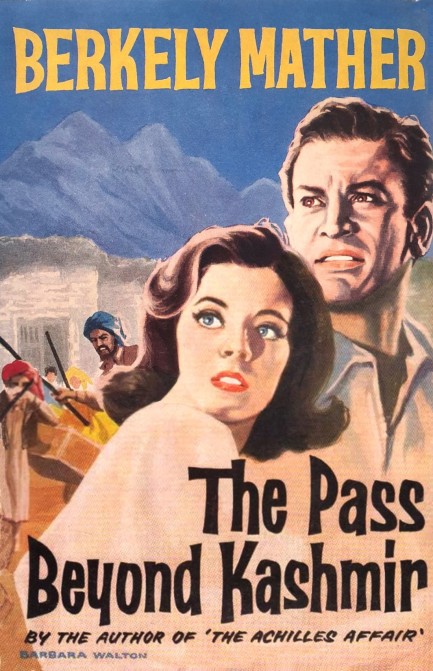
The cover you see above for Berkely Mather's, aka John Evan Weston-Davies', 1960 adventure The Pass Beyond Kashmir is one of the more pleasing we've come across. It's by Barbara Walton, a preeminent dust sleeve illustrator from the 1950s until around 2000. We've featured her a few times, such as here, here, and here, and this effort maintains her incredibly high standard. The scene depicted makes one think there's a major romantic subplot in the novel, but the love interest is in the book for maybe twenty pages. It isn't Walton's fault that the art gave us expectations that weren't met. It happens with covers sometimes. No romantic adventure here.
The story actually revolves around a sardonic and extremely determined ex-intelligence operative named Idwal Rees who gets caught up in a search for missing documents in the Himalayas that might reveal the location of an oil discovery. The action takes the form of a quest from Bombay-Mumbai into the high mountains, with new difficulties encountered in each stop by he and partner Smedley, servant Safaraz, and reluctant informer Poison. Each obstacle is followed by desperate problem solving, and hairsbreadth escapes. The aforementioned sort-of love interest, a nurse named Claire Culverton, is mainly a source of consternation for Rees and a focus for his chauvinism.
The set-up and framework are fine, but we felt that the book got bogged down with too much local color. Obviously, authors wish to impart that they've at a minimum done their homework, and at a maximum lived some version of what they're writing about, but there's also such a thing as narrative flow. We get it—Mather was really in India and Pakistan. He even served in the army there. But in our opinion he needed another pass from an editor to make for a better book. Still, as it resolved, it was decent, though anyone of Indian, Pakistani, or Chinese descent—or of good conscience—will bristle at the treatment meted out by Rees and other Brits. But you know that going in, right?
 We'll talk more about how uncivilized you people are later. Right now I'm going to kill rare animals purely for ego. 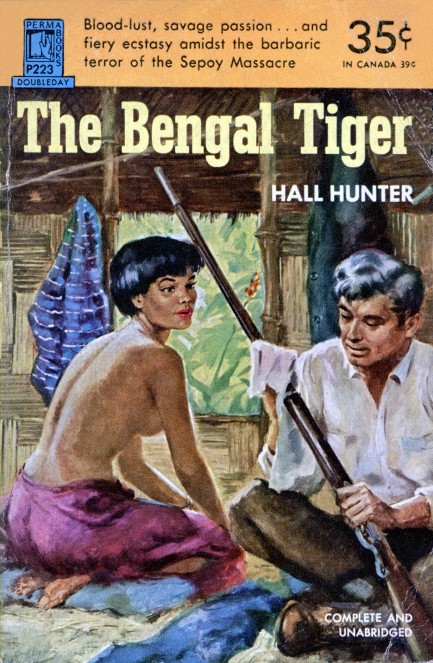
Above is a nice Carl Bobertz cover for Hall Hunter's, aka Edison Marshall's novel The Bengal Tiger, set in India during late 1850s. The lesson here is that he who prints the books establishes the narrative. The “barbaric terror of the Sepoy massacre” against England and its British East India Company caused about 2,400 British fatalities, according to official records of the time, but the toll is now thought to have been about 6,000. The Brits didn't bother to keep track of Indian deaths, but the change in recorded population between the previous census and the next indicated hundreds of thousands were killed. On a level orders of magnitude more disturbing is the fact that during the British occupation of India at least 40 million Indians, and possibly more than 100 million, were killed or starved to death.
If you were to ask Brits about the deadliness of their empire, most would not believe it, and many would try to excuse it. That's no surprise. Generally, the citizens of the expansionist powers can only deal with such horrors by first denying the truth, then if that fails, suggesting that there's a statute of limitations on mass murder. It happens, for example, whenever someone brings up slavery and westward expansion in the U.S. “It had nothing to do with me, or anyone else alive today.” However, over on the opposite side of reality where anti-Floridian concepts like factual history and mathematics reside, there are widely agreed upon studies revealing that—in Britain's case—$45 trillion in wealth was drained from India over about 170 years. That amount of gain has very much to do with everyone alive today, and in the future. Have a good Monday!
 Anger is a dish best served twice. 
Remember the men's magazine covers of elephant attacks we posted not long ago? Late last week a woman named Maya Murmu in the Indian state of Odisha was drawing water from a well when she was attacked by an elephant. The animal apparently charged her, knocked her down, trampled her, and left her smashed into the dust. An ambulance was called but Murmu succumbed to her injuries. This is where the story gets weird. Murmu's family arranged for a funeral the next day via the traditional method of outdoor burning, but during the ceremony the same elephant appeared, grabbed the corpse from the pyre, flung it into the air, trampled it, and fled.
This is a really angry elephant we're talking about, because that's seriously gangsta behavior—like Gotti level, like something from a rap song. Stomp you once, shame on you, stomp you twice, you deserved that too. Not that Murmu did anything to deserve it. But elephants are supposed to have good memories, so that's where our minds immediately went, and yours too, we bet. Reports from Odisha say the attack was unprovoked, but something set off the animal. Business deal gone wrong, personal betrayal, something. Currently it's still at large. Authorities think it escaped from the Dalma Wildlife Sanctuary in the adjacent state of Jharkhand, but for now its whereabouts are unknown, and really, we wouldn't recommend searching for it.
We dug around for a photo of the events mentioned, and did in fact find a shot that seems to show Murmu's family gathered around her body but even we aren't morbid enough to use it. We already get more than enough nightmare fuel doing this website. One of the reports we found also had a blurry elephant photo we took to be the angry pachyderm, but without a caption we couldn't be sure. That being the case, at top you get a shot of an unrelated animal not involved in the Odisha attack. We may update this strange saga if anything new and interesting comes across, but even with the scant information available it's a story so bizarre—and so pulp—that we had to mention it. If you want to see fifty amazing magazine covers of elephant attacks, just click here.
 Calcutta is heavy on looks but light on substance. 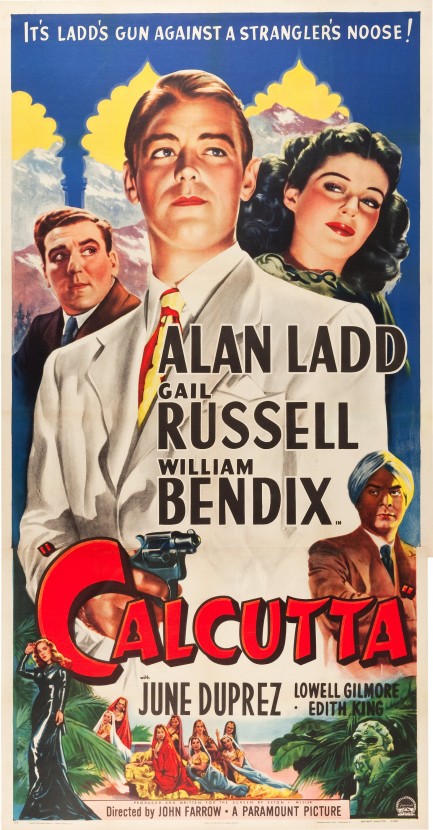
We'll tell you right out that Calcutta came very close to being an excellent movie, but doesn't quite get over the hump. It deals with a trio of pilots flying cargo between India and China on fictional China International Airways. The trio, Alan Ladd, William Bendix, and John Whitney, stumble upon a highly profitable international smuggling ring and quickly find that the villains play for keeps. Along with the fliers, the film has Gail Russell as Whitney's girlfriend, and June Duprez as a slinky nightclub singer. While the exotic setting marks the film as an adventure, it also fits the brief as a film noir, particularly in Ladd's cynical and icy protagonist.
As we said, the movie isn't as good as it should be, but there are some positives. Foremost among them is Edith King as a wealthy jewel merchant. She smokes a fat cigar, the masculine affectation an unspoken but clear hint of her possible lesbianism, and with a sort of jocular grandiosity simply nails her part. Another big plus is the fact that the miniature work (used in airport scenes), elaborate sets and props, and costumed extras all make for a convincing Indian illusion—definitely needed when a movie is filmed entirely in California and Arizona (Yuma City and Tucson sometimes served as stand-ins for exotic Asian cities, for example Damascus in Humphrey Bogart's Sirocco).
On the negative side, Calcutta has two narrative problems: the head villain is immediately guessable; and Russell is asked to take on more than she can handle as an actress, particularly as the movie nears its climax. Another problem for some viewers, but not all, is that the movie has the usual issues of white-centered stories set in Asia (or Africa). However, within the fictional milieu the characters themselves seem pretty much color and culture blind, which isn't always the case with old films. Even so, the phalanxes of loyal Indian servants, and the dismissiveness with which they're treated—though that treatment is historically accurate—probably won't sit well with a portion of viewers.
Here's what to focus on: Alan Ladd. He's a great screen presence, a solid actor in the tight-lipped way you often see in period crime films, and the filmmakers were even smart enough to keep him shirtless and oiled for one scene. We swear we heard eight-decade-old sighs on the wind, or maybe that was the Pulp Intl. girlfriends. They'd never seen Ladd before, but immediately became interested in his other films. We were forced to tell them he was a shrimpy 5' 6” and they were a bit bummed. But he had it—and that's what counted. His it makes all his films watchable, but doesn't quite make this one a high ranker. Calcutta had its official world premiere in London today in 1946.
 Will His Majesty be cleaning the bathroom today? Because His Majesty's wife will not. 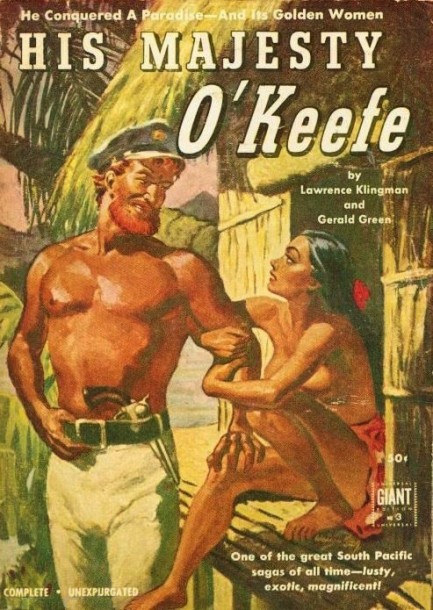
We've spent some time in tropical countries, which makes it hard for us to resist books with tropical settings. The above, His Majesty O'Keefe, is amazingly obscure considering it was made into a 1954 film by Warner Bros. starring Burt Lancaster. What you get here is a fictionalized account of actual Irish American roustabout as David Dean O'Keefe, who in 1870 flees a murder charge in Georgia by sailing away to the other side of the world. He ends up on the island of Yap, then part of Spanish East India, today part of Micronesia, and establishes himself as a respected copra trader. Other South Seas books tend toward irony and tragedy, but here O'Keefe achieves amazing success. From Yap he expands his trade to other islands, and becomes known as the King of Yap, the Monarch of Mapia, and the Sovereign of Sonsorol.
In addition, he's an enlightened type. We don't know if that part is true, considering the book was written nearly a lifetime after the real O'Keefe's death, and considering the authors Lawrence Klingman and Gerald Green seem to have a bone to pick with Germans, who are portrayed as racist brutes. We can understand that. It was published only five years after World War II, but weren't all colonials racist brutes? We suspect O'Keefe is portrayed better than he really was in order to create contrast with the hated Germans. The real O'Keefe ran Confederate cargos through Union naval blockades during the U.S. Civil War, so how enlightened could he have been? But it's possible he was opportunistic more than he was political. Or the blockade busting could have been pure fabrication. O'Keefe said so when investigated in 1867, but then what would he say?
But whatever—we're talking about the book, and we'll take the respectful and equality-minded character here over the bigoted heroes that tend to dominate novels set around this period. We're still reeling over Slave Ship. We won't go into how Klingman and Green conclude their story. We'll just say the result is pretty entertaining. We suspect the movie version is g-rated by comparison, and for sure it will be a whitewash historically, but we're going to look for it and have a watch. It has Lancaster, after all, and he's one of the reliable indicators of quality in vintage cinema—he's no Bogart or Cary Grant, mind you, but his movies tend to be good. We'll report back. His Majesty O'Keefe was originally published in 1950, and this Universal Giant edition came in 1952 with cover art by Warren King.
 To billions of people I'm a superstar but you have the nerve ask who I am? You are so dead. 
Above, an awesome image of Indian actress Rekha—née Bhanurekha Ganesan—from her hit fantasy adventure film Nagin, which is the fantastic tale of a magical snake that takes human form in order to revenge-kill some hunters. Rekha wasn't the snake in the movie, but she looks ready to kill too. Obviously, the fact that she's a one-name star indicates her level of fame, and though that recognition never quite took hold outside Asia, several billion people recognize her as one of the cinematic greats. Our loss, their gain. Nagin premiered in India today in 1976, so this photo would have been made sometime in 1975.
 Go ahead. Try putting yourself in her position. 
Let's face it. None of us have toes strong enough to support our weight for longer than it takes to get the pancake syrup off a high kitchen shelf. Just looking at this photo causes us sympathetic pain. The image shows Sujata, who was an Indian dancer who rose to fame in golden age Bollywood before crossing the sea and appearing in numerous U.S. movies beginning in the early 1950s. In addition to her film work she toured the U.S. as half of the duo Sujata and Asoka, performing Indian, Tibetan, and other Eastern dances for amazed audiences. This shot is from the heyday of her touring period, when her toes were at their very strongest, probably around 1955.
 Ursula the friendly witch. 
Witches are supposed to be scary but Ursula Jeans didn't get the memo, seemingly, as she prepares to take her broom out for a spin while wearing a rather enticing nightgown. On the other hand, maybe the nightgown is just a lure and the basket is to transport your corpse once she kills you and crushes you like an egg carton. You never know when it comes to witches. Jeans was born in 1906 in British India and launched her showbiz career on the London stage in 1922. She naturally made the transition to cinema and her films include The Barton Mystery, Dark Journey, and The Weaker Sex. This shot is identified all over the internet as being from 1965, which would be amazing if true, because she'd be fifty-nine years old in it. So, barring the evil practice of black magic to stay young, and assuming Jeans' broom doesn't have a flux capacitor built into it, let's say this shot is actually from around 1935.
 America's oldest tabloid continues its appointed rounds. 
Today we have the cover and some interior scans from an October 1971 issue of the National Police Gazette, which dutifully explores its usual realms of sports, crime, and Hollywood. The magazine was founded in 1845, which is always astounding to consider. We bought a pile of these ages ago. In fact, they were the first bulk purchase of tabloids we ever made for the website. These ’70s issues of Gazette tend to be very cheap, but, as late stage editions, don't hold much intrigue, which is why we hadn't scanned one since 2014. But we have to clear some space in our Pulp cave, so we scanned this one and immediately sailed it into the recycling bin. On the cover you have Samantha Marsh, and inside you get Joe Louis and Max Schmeling, Australian model Deanne Soutar, speculations on how old men can be and still have sex, hashish smugglers from India, and a story on the mysterious death of actress Thelma Todd. More from Police Gazette coming soon. 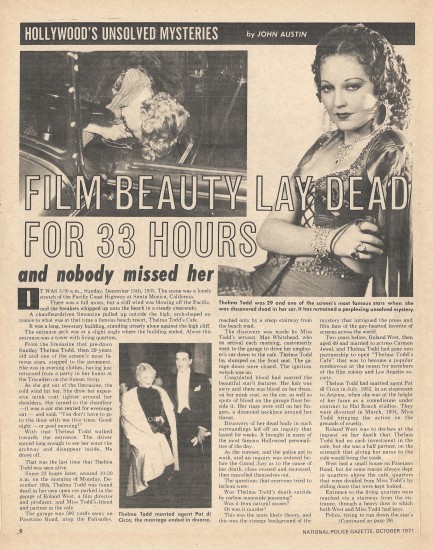      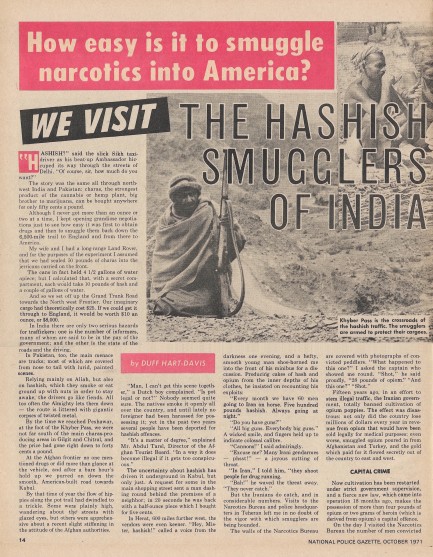 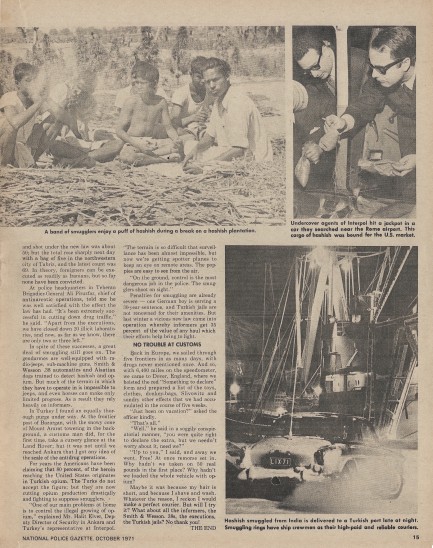      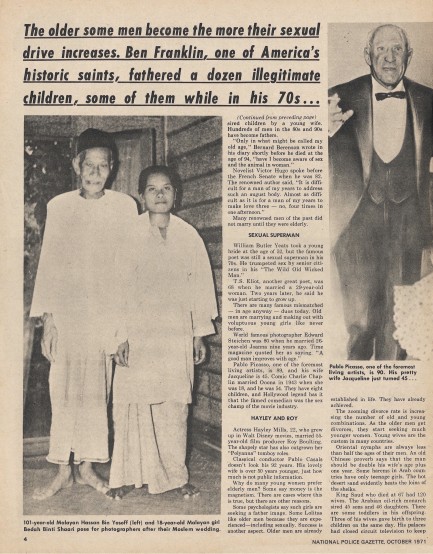    
 John Dillinger's body—most of it anyway—to be exhumed in September. 
At the request of his family, Great Depression-era gangster John Dillinger will be exhumed from the Indianapolis grave where he was buried in 1934 after being shot down by FBI agents outside the Biograph Theater in Chicago. There's been no official explanation for the request, however the dig should resolve a couple of pieces of Dillinger folklore. The first would be whether it's him in the grave at all—an urban legend that the FBI shot the wrong man has simmered since his death. And the second would be whether there's a cock attached to the corpse—a particularly odd legend suggests that Dillinger had a monster member that was somehow snipped before burial and whisked away by a morbid collector.
The rumor of body part theft is no surprise. Grave robberies had been a problem in the U.S. throughout the 1800s, and while these had waned by 1934, as a precaution Dillinger was buried under scrap iron and slabs of concrete covered by a layer of poured cement. The bit about him being hung like a mule is harder to trace. Some say it was caused by a morgue photo which appeared (if you really used your imagination) 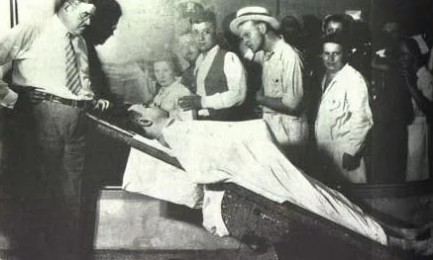 to show him with an erection, but being the subject of at least one Tijuana bible certainly didn't hurt either. In the dirty comic “A Hasty Exit,” which we think was published in mid-1934 before his death, Dillinger uses a massive unit to pleasure his girlfriend Evelyn Frechette and her pal Nellie. Of course, everyone in Tijuana bibles had dinosaur dicks, but we're speculating here. to show him with an erection, but being the subject of at least one Tijuana bible certainly didn't hurt either. In the dirty comic “A Hasty Exit,” which we think was published in mid-1934 before his death, Dillinger uses a massive unit to pleasure his girlfriend Evelyn Frechette and her pal Nellie. Of course, everyone in Tijuana bibles had dinosaur dicks, but we're speculating here.
It's possible the public won't find out why Dillinger is being 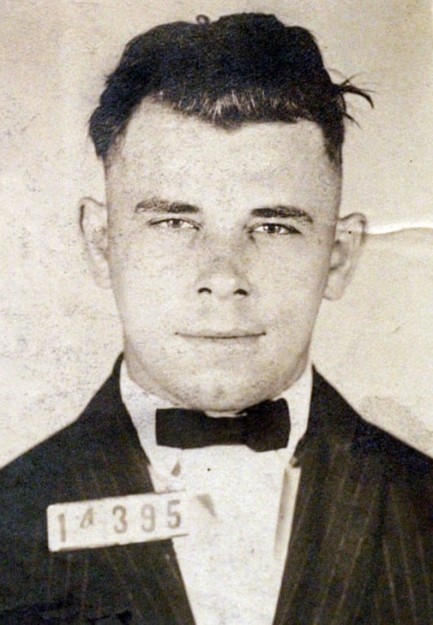 brought back above ground (though DNA testing to prove ancestry seems like a good bet), or whether all the famed gangster's parts are intact. We doubt most people actually care. But for us pulp followers the story is somewhat interesting, because Dillinger is an icon of the pulp era. brought back above ground (though DNA testing to prove ancestry seems like a good bet), or whether all the famed gangster's parts are intact. We doubt most people actually care. But for us pulp followers the story is somewhat interesting, because Dillinger is an icon of the pulp era. As a bonus, the story has also served as a reminder that we have many more filthy Tijuana bibles we need to upload. We'll get to that as soon as we can. In the meantime, while we all wait for that September exhumation to finally settle longstanding urban legends, you can satisfy your historical interest in John Dillinger by exhuming his Tijuana bible here.

|
 |

The headlines that mattered yesteryear.
2003—Hope Dies
Film legend Bob Hope dies of pneumonia two months after celebrating his 100th birthday. 1945—Churchill Given the Sack
In spite of admiring Winston Churchill as a great wartime leader, Britons elect
Clement Attlee the nation's new prime minister in a sweeping victory for the Labour Party over the Conservatives. 1952—Evita Peron Dies
Eva Duarte de Peron, aka Evita, wife of the president of the Argentine Republic, dies from cancer at age 33. Evita had brought the working classes into a position of political power never witnessed before, but was hated by the nation's powerful military class. She is lain to rest in Milan, Italy in a secret grave under a nun's name, but is eventually returned to Argentina for reburial beside her husband in 1974. 1943—Mussolini Calls It Quits
Italian dictator Benito Mussolini steps down as head of the armed forces and the government. It soon becomes clear that Il Duce did not relinquish power voluntarily, but was forced to resign after former Fascist colleagues turned against him. He is later installed by Germany as leader of the Italian Social Republic in the north of the country, but is killed by partisans in 1945.
|

|
|

It's easy. We have an uploader that makes it a snap. Use it to submit your art, text, header, and subhead. Your post can be funny, serious, or anything in between, as long as it's vintage pulp. You'll get a byline and experience the fleeting pride of free authorship. We'll edit your post for typos, but the rest is up to you. Click here to give us your best shot.

|
|








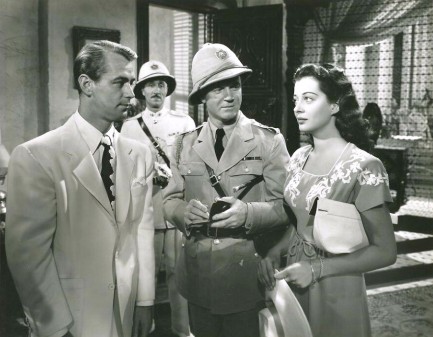


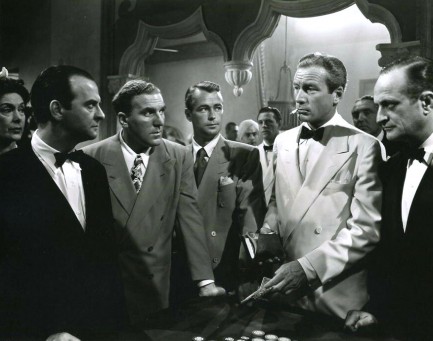
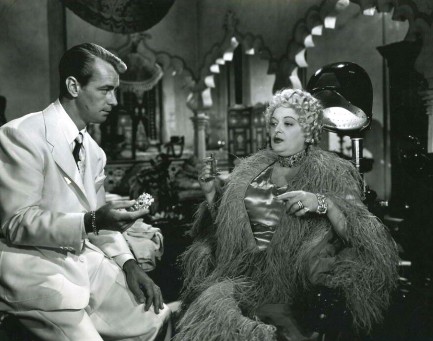


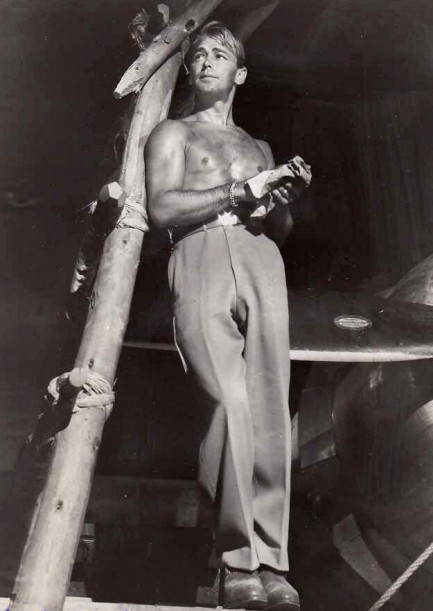

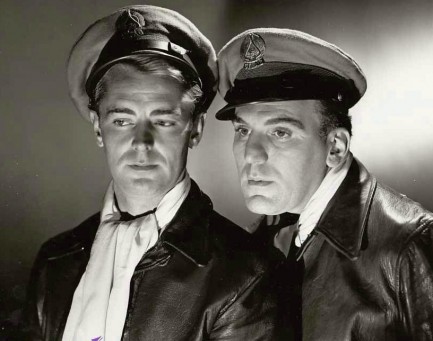
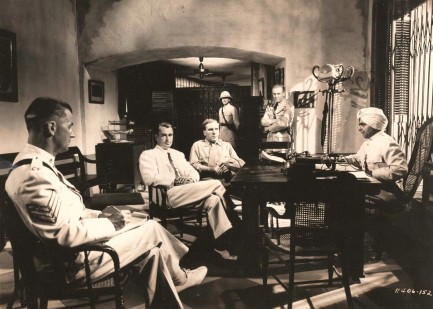



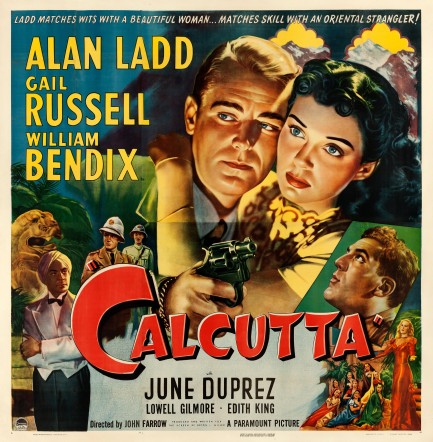






























 to show him with an erection, but being the subject of at least one Tijuana bible certainly didn't hurt either. In the dirty comic “A Hasty Exit,” which we think was published in mid-1934 before his death, Dillinger uses a massive unit to pleasure his girlfriend Evelyn Frechette and her pal Nellie. Of course, everyone in Tijuana bibles had dinosaur dicks, but we're speculating here.
to show him with an erection, but being the subject of at least one Tijuana bible certainly didn't hurt either. In the dirty comic “A Hasty Exit,” which we think was published in mid-1934 before his death, Dillinger uses a massive unit to pleasure his girlfriend Evelyn Frechette and her pal Nellie. Of course, everyone in Tijuana bibles had dinosaur dicks, but we're speculating here. brought back above ground (though DNA testing to prove ancestry seems like a good bet), or whether all the famed gangster's parts are intact. We doubt most people actually care. But for us pulp followers the story is somewhat interesting, because Dillinger is an icon of the pulp era.
brought back above ground (though DNA testing to prove ancestry seems like a good bet), or whether all the famed gangster's parts are intact. We doubt most people actually care. But for us pulp followers the story is somewhat interesting, because Dillinger is an icon of the pulp era.




































































